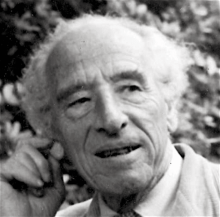
Bertram Clough Williams-Ellis [commonly known as Clough Williams-Ellis; and as Sir Clough Williams-Ellis] was born in Gayton, Northamptonshire, England on 28 May 1883 and moved to North Wales with his family when he was four years old. He studied natural sciences at Trinity, College, Cambridge and then studied for a few months at the Architectural Association School in London in 1903-04. He was also briefly articled to a Sussex builder before setting up his own independent architectural practice in London in 1905. In c.1908 he formed a partnership with James Buyers Scott (1882-1956) as Williams-Ellis & Scott. The association was short-lived and the partnership was dissolved in 1911.
Following World War One, in which he served with distinction, Williams-Ellis increasingly began to focus his attention on conservation and environmental issues, campaigning for more effective town and country planning. He outlined his views in a series of articles, his books, England and the Octopus (1928) and Britain and the Beast (1937), and two influential pamphlets, Cautionary Guide to Oxford (1930), Cautionary Guide to St Albans (1930), both published by the Design and Industries Association of which he was President. He was also an active supporter of the National Trust, and the Council for the Protection of Rural England.
In 1925 he began work on the design and construction of the village of Portmeirion in Merieoneth, Wales, an Italianate holiday complex that was to absorb his attention for the next fifty years, and was to become the project for which he is best known.
After World War Two he was appointed Chairman of Stevenage New Town Development Corporation but soon grew tired of the bureaucracy involved and resigned.
Williams-Ellis was elected a Fellow of the Royal Institute of British Architects (FRIBA) in 1929 and in 1972 he was knighted. He died at his home, Plas Brondanw, Llanfrothen, Wales on 8 April 1978.
Reconstructions and restorations: Bolesworth Castle, Llangoed Castle, Wolvcrton Court, Burton Court, Coed Coch, Oare House, and Stowe House. Bishop's Stortford College Chapel; First Church of Christ. Scientist, Belfast: Princess Christian Colony, Kent; Memorial Hospital, Blaneau Festiniog; Lord Macnaghten Memorial Hall and Schools, Co. Antrim; Central Schools, Bushmills. New houses; Bidgelands, Berks; Cold Blow, Wilts; Cumnor House, Oxon; Pentrefelin, N. Wales; Caversham Place, Berks; and various London works, mostly private residences. [Source: Who's Who in Architecture 1926]
______
See also
'Bolesworth Castle and its Renaissance'. Architectural Review vol. 57, April 1925 pp. 149-153 [Discusses the partial remodelling by Williams-Ellis of Bolesworth Castle in Tattenhall, Cheshire between 1920 and 1923]
Directory of British Architects 1834-1914. Compiled by Antonia Brodie, et al. Volume 2: L-Z. London; New York: British Architectural Library, Royal Institute of British Architects/Continuum, 2001
‘Editorial Notes: Clough Willams-Ellis’. The Town Planning Review vol. 54, no. 4, October 1983 pp.380-383
Foulkes, Elizabeth. 'Clough has gone'. The Architect vol. 124, no. 8, August 1978 pp. 44-45
Gruffudd, Pyrs. 'Propaganda for seemliness': Clough Williams-Ellis and Portmeirion, 1918-1950. Ecumene vol. 2, no. 4, October 1995 pp. 399-422
Harrison, Nigel and Robertson, Iain J. ‘Beyond Portmeirion: The Architecture, Planning and Protests of Clough Williams-Ellis’. in: Rural Modernity in Britain: A Critical Intervention. Edinburgh: Edinburgh University Press, 2018 pp. 187-206
Harrison, Nigel G. 'Architect errant' : a critical study of the work and legacy of Clough Williams-Ellis. Ph.D. thesis, University of Gloucestershire, 2014.
Haslam, Richard. Clough Williams-Ellis. London: Academy Editions, 1996
Haslam, Richard. ‘Wales’s Universal Architect. Sir Clough Williams-Ellis (1883-1978)’ Country Life 21 July 1983 pp.130-132
'Houses after the war, II: for a site on the Welsh Coast'. Country Life vol. 89, 4 January 1941 pp. 16-17 [Plans and sketches by Williams-Ellis for houses in Wales. The name of the client and the location of the site are not given in the article]
Jones, Jonas. Clough Williams-Ellis : architect of Portmeirion. Bridgend: Seren, 1998
'Obituary'. The Architects' Journal vol. 167, no. 15, 12 April 1978 p. 688
'Obituary'. Architectural Review vol. 164, no. 978, August 1978 p. 68
Reilly, C. H. Representative British Architects of the Present Day. London: B. T. Batsford, 1931 [Chapter VII. Clough Williams-Ellis pp. 88-97]
Wharton, Kate. 'Passport to pleasure'. Architect and Building News vol. 6, 18 June 1970 pp. 24-29 [Discusses the mixture of architectural styles at Portmeirion]
Who's Who in Architecture 1926. Edited by Frederick Chatterton. London: Architectural Press, 1926
Williams-Ellis, Anabel. Clough Williams-Ellis: a portrait in words. Penrhyndeudraeth, Gwynedd: Golden Dragon Books, 1981
Williams-Ellis, Clough. Architect Errant: The Autobiography of Clough Williams Ellis. London, Constable, 1971
Williams-Ellis, Clough. Portmeirion : its What? When? Why? and How variously answered. Penrhyndeudraeth, Gwynedd : Portmeirion, 1973